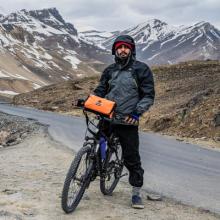
Cause:
Altitude sickness can occur when traveling to an altitude above 6,000 feet (1,829 meters) and traveling faster than the body can adapt.
Are you traveling to a high altitude destination? Here are altitudes of some common destinations:
Cuzco, Peru = 11,203 feet (3395 meters)
Quito, Ecuador = 9,252 feet (2820 meters)
Lhasa, Tibet = 13,000 feet (3965 meters)
OR you can Google your destination and altitude now.
Although people can adjust to altitude changes, the process takes time. Travel by plane, car or bus and even hiking may not give you enough time to adjust, and you may develop altitude sickness.
Altitude sickness develops during or after ascent (going up). Fluid leakage from blood vessels seems to be the main cause of symptoms.
To avoid severe illness and death, keep in mind three rules:
1. Learn the early symptoms of altitude sickness, and notice and acknowledge if you have them. Symptoms can develop within hours after ascending to a higher altitude. Symptoms are:
Headache
Insomnia
Irritability
Dizziness
Muscle Aches
Fatigue
Loss of Appetite
Nausea
Vomiting
Swelling of face, hands, feet
2. Never ascend to sleep at a higher altitude when experiencing any of the symptoms of altitude sickness, no matter how minor they seem.
3. Descend if symptoms become worse while resting at the same altitude.
What to do:
Acute mountain sickness (AMS) can develop within hours after ascending to a higher altitude. Symptoms may include headache, insomnia, irritability, dizziness, muscle aches, fatigue, loss of appetite, nausea, vomiting, and swelling of the face, hands and feet. Limit your activity level and remain at the same altitude for a day or two before resuming your ascent. Aspirin or ibuprofen may be used for headache. Drink plenty of water. If symptoms worsen during a day of rest, descend until you improve.
Severe forms of altitude sickness are high altitude cerebral edema (HACE) and high altitude pulmonary edema (HAPE). Danger signs of severe altitude sickness include severe headache, extreme fatigue or breathlessness (especially while resting), and any neurological problems such as stumbling, confusion, poor judgment or changes in consciousness. HACE and HAPE are medical emergencies and may result in coma or even death. It is crucial to descend and receive drug and oxygen therapy as soon as possible.
More on prevention:
The key to prevention is to ascend slowly and include rest days at intermediate altitudes.
Avoid overexertion during the first few days at a high altitude.
Drink plenty of water.
Avoid alcohol and unnecessary medications because the effects may be increased at high altitude.
Avoid drugs that decrease breathing rate, such as sleeping pills, tranquilizers and narcotic-based pain relievers.
A diet high in carbohydrates may be beneficial.
Consult your health care provider if you:
Have heart or lung problems
Plan to go to extremely high altitude
Have had altitude sickness in the past, and if you have had had HACE or HAPE, you should not return to high altitude due to high risk
Are interested in a prescription medication, Acetazolamide (Diamox), that can prevent altitude sickness if taken before ascent; it increases breathing rate and speeds adjustment
